New Jersey Future Blog
Access to Parks is an Environmental Justice Issue
April 19th, 2023 by Hannah Reynolds
Conversations around environmental justice (EJ) and social determinants of health are commonly focused on the inequities that are present in underserved communities: the dangerous developments and contaminants. Often, the focus of environmental justice efforts is on remediating the lead and forever chemicals like PFAS found in the drinking water of low-income communities, or cleaning up the massive superfund sites or improving air quality near freeways that are often sited in communities of color. So naturally, there is a limited discourse in the environmental justice movement on what is missing in communities that have been historically marginalized, especially when it comes to things taken for granted as amenity, like parks.
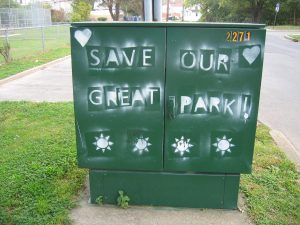
Camden, New Jersey
“To provide an overarching perspective, there are 100 million people in the United States—of which 28 million are children—who don’t have access to a park within a ten-minute walk of their homes. That’s an equity statement,” said Scott Dvorak, the Associate Vice President and New Jersey State Director of the Trust for Public Land. “In communities of color, the parks people do have access to are, on average, half the size and serve five times as many people as those in privileged areas. In these parks, the programming needs and demand are higher, but the entities responsible for maintaining the parks often have restricted resources.”
Nearly a third of Americans do not have easy access to parks, making access to parks and public space a luxury in our country. However, the data shows striking disparities in park access for people in underserved communities and from marginalized backgrounds. An estimated 76% of people living in low-income communities of color live in places deprived of nature, with communities of color experiencing roughly triple the rate of nature deprivation compared with predominantly white communities. Consequently, people living in low-income, majority-minority communities disproportionately experience firsthand the impacts of the destruction of nature related to air and water pollution, waning biodiversity and the spread of diseases, and the impacts of climate change, to name a few. In New Jersey, Governor Phil Murphy has moved to cut admission fees to state parks, with the state charging no state park fees in 2022 and seeking to do the same in summer 2023. By reducing cost barriers to visiting parks, New Jersey has taken great strides toward creating more accessible parks for all New Jerseyans to enjoy. But why is access to parks so important for promoting environmental justice?
The accessibility, availability, and funding of parks plays a crucial role in health outcomes. One major function of parks for health is to foster access to open space for exercise and physical activity. The Centers for Disease Control and Prevention recommends that young people get at least an hour of physical activity per day and that adults do at least an hour and a half of aerobic activity each week to stay healthy. However, the majority of Americans do not get enough exercise, with only 25% of adults meeting these recommendations and with nearly a third of American adults engaging in no exercise in their leisure time.
Lack of physical activity is associated with a number of physical health concerns including obesity, high blood pressure, high blood cholesterol, heart failure, stroke, osteoarthritis, reproductive and bladder issues, and pregnancy complications, as well as many mental health concerns like depression, eating disorders, and low self-esteem. Overall, the trends of insufficient exercise and physical health concerns within the population hold serious ramifications for the wellbeing of Americans.
However, access to parks offers opportunities for health outcomes to be improved, with the availability and accessibility of green outdoor spaces for recreation acting as social determinants of health. When Americans obtain increased access to parks and advertisements about park offerings, events, and amenities, studies show that exercise can increase in frequency by nearly 50%. At the same time, energy levels, weight loss, and flexibility generally improve with heightened access to a place for exercise. Further, mental health is significantly associated with access to parks and nature, with reports of heightened attention, mood, and cognitive functioning, as well as reduced stress.
Beyond this, the benefits of accessible parks extend to community health, with social cohesion and economic outcomes—such as lowered healthcare spending and heightened financial security—are also found to be correlated with park accessibility. In other words, reliable access to parks and open outdoor spaces promotes exercise and consequently boost health outcomes in an otherwise too-sedentary population. Therefore, park equity can and should be considered a matter of environmental justice just as much as contaminated water or toxic construction sites.
Beyond supporting health outcomes, green spaces can benefit the natural environment, curbing urban heat island effects, supporting stormwater management naturally, and enhancing air quality. Reduced air pollution related to parks can lower rates of asthma, which disproportionately impacts people of color, and has been found to be associated with the spread and mortality of COVID-19. Altogether, it becomes clear that low-income areas with high sprawl development—where the expectation of driving limits access to parks and green spaces for low-income people—can negatively impact health outcomes, posing a serious inequity for marginalized and underserved populations—which begs the question, why aren’t we investing more in parks?
Beyond mere access to green space, equity issues around parks extend to quality and upkeep of these public spaces, as well as the safety of walking or biking to a given park. While two-thirds of Americans have access to parks within a 10-minute walk, according to Scott Dvorak, there remains vast disparities around quality, size, demand, and maintenance of parks. Many parks situated within low-income communities of color are often poorly maintained, dangerous, understaffed, or underfunded. Investing in existing parks to create safe, clean, resilient parks for all to enjoy will meet the demands of the communities they serve. Not only that, but maintenance of green spaces saves money. One study reports that for every one dollar spent on creating and maintaining park trails, three dollars of healthcare spending can be saved.
However, the ability to walk to a park within a ten-minute radius does not guarantee that the infrastructure and streets to get there are safe, clean, or even present. Especially in low-income communities, there may not even be sidewalks connecting local people to such parks. Therefore, if a park is only truly accessible by driving, this will limit who can enjoy a park, preventing many low-income people from spending time at the park. Though New Jersey ranks second in the country for most land dedicated to park spaces, as the nation’s most densely-populated state, urban sprawl, disinvestment in urban areas that largely consist of people of color and people with lower socioeconomic status, lack of connectivity, and poor planning all have contributed to determining which New Jerseyans have easy and safe access to parks, which is certainly not equitable or inclusive for all. Through all of this, it is clear that equity around park access is dependent upon not only the presence of parks, but also their quality.
“Accessibility is not only, of course, about race and income. It’s also about ability, age, special needs, and making parks accessible for the whole spectrum of human condition.” Scott Dvorak of the Trust for Public Lands put it well. It is crucial to not only advocate for increased availability of parks, but also to ensure that parks have proper funding, maintenance, staffing, and connectivity with the community, in order for local peoples to enjoy all the benefits of public spaces and parks. At present, too many Americans lack access to nearby parks and the environmental and health benefits they offer, demonstrating that park access can act as a predictor of health outcomes. Ultimately, if we are to achieve an environmentally-just world, equitable and reliable access to parks and open spaces for all people is an essential step.
From Federal Dollars to State Investment: Understanding Technical Assistance for Water Systems
April 17th, 2023 by Diane Schrauth
At New Jersey Future’s Planning and Redevelopment Conference in June 2022, New Jersey Commissioner of Environmental Protection, Shawn LaTourette, emphasized the historic funding opportunities for NJ flowing from the federal government and implored attendees, “If you don’t have a grant writer on staff, hire one. If you do have one, hire a second.” LaTourette concluded his remarks by stating his desire for New Jersey to seize the opportunity for federal funding, and to position itself well for any additional rounds of funding.
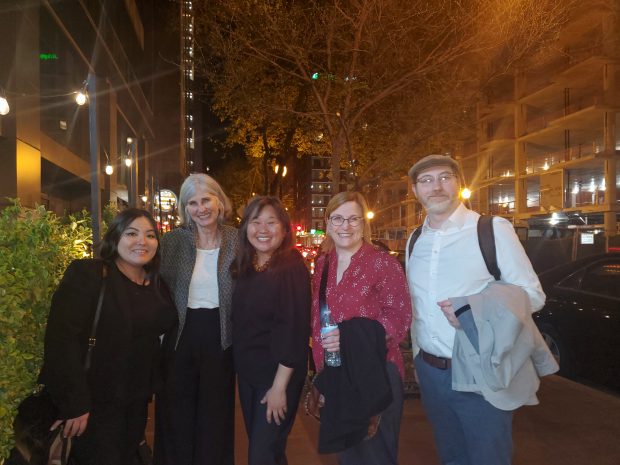
New Jersey Future at the CIFA Summit on Water Infrastructure. From left to right: NJF Funding Navigator Program Manager Aoi Morel, Environmental Policy Innovation Center Funding Navigator Director Denise Schmidt, US Water Alliance CEO Mami Hara, NJF Policy Director of Water Diane Schrauth, and US Water Alliance Director of Policy and Government Affairs Scott Berry.
New Jersey Future (NJF) is partnering with a national organization, the Environmental Policy Innovation Center, as its on the ground partner in New Jersey for its national Funding Navigator program. The Funding Navigator will provide technical assistance to help water systems and municipalities—particularly those serving overburdened communities—access federal and state funding for water, sewer and stormwater issues. New Jersey’s Funding Navigator will formally launch later this month (April 2023).
As NJF highlighted in a blog from November, New Jersey has a myriad of water infrastructure needs, including addressing combined sewer overflows, achieving full lead service line replacement by 2031, and increasing stormwater requirements. New Jersey was an industrial powerhouse in the 19th century, which led to rapid development and construction of infrastructure to accommodate a growing population. The many systems that comprise our statewide water infrastructure are, in many cases, over a century old, and in dire need of replacement. With the Bipartisan Infrastructure Law (BIL) there is roughly four times as much funding available for water infrastructure projects as usual. This funding is sorely needed, with at least a $30 billion price tag for water infrastructure improvements over the next 20 years in New Jersey.
National research shows that smaller communities and communities of color are less likely to access federal and state water infrastructure funding. The Funding Navigator will work with water systems and municipalities servicing those communities to help access that funding by facilitating connections to finance and funding streams, technical assistance, and community engagement.
If you’re interested in learning more about NJF’s Funding Navigator once it’s launched, please fill out this form for our team to follow up with you.
As we work to get our New Jersey Funding Navigator off the ground, we want to help folks understand the various technical assistance programs available at the federal, regional, and state levels. NJF will be partnering with many of these entities, which are also in the process of getting their programs up and running.
National Technical Assistance Providers
The US Environmental Protection Agency (EPA) has provided funding to a set of national and regional organizations through its Environmental Finance Centers program to help communities access funds for infrastructure projects. National Technical Assistance Providers and their likely areas of emphasis:
- Environmental Policy Innovation Center (Sand County Foundation is the fiscal sponsor)— lead service line replacement and small-to-midsize systems
- Moonshot Missions—needs assessment
- Rural Community Assistance Partnership (RCAP)—rural systems
- U.S. Water Alliance—large systems
Communities interested in requesting free EPA water assistance can fill out a simple interest form on their Water Technical Assistance program page.
Regional Technical Assistance Providers Serving New Jersey
The Syracuse University—Environmental Finance Center works with communities in New Jersey, New York, and Puerto Rico to help access funding and financing for municipal water infrastructure. Partners will include Cornell College of Agriculture and Life Sciences, Moonshot Missions, New Jersey Future, Quantified Ventures, and RCAP Solutions.
Technical Assistance Programs in New Jersey
- The EPA’s Lead Service Line Replacement Accelerator Program will provide targeted technical assistance services to underserved communities to make progress on replacing lead pipes that pose risks to the health of children and families. A consultant will work with these communities directly with support from the EPA. The accelerators will collectively work in 40 communities across the four states—Connecticut, New Jersey, Pennsylvania, and Wisconsin—to accelerate lead service line projects by supporting the development of:community engagement plans, lead service line inventories, lead service line replacement plans, State Revolving Fund funding applications. NJF is a partner in this program.
- New Jersey Department of Environmental Protection (NJDEP)
- NJDEP offers no-cost assistance using its contracted technical service providers to water systems for various activities such as engineering services, program navigation, and financial and needs assessments. Water systems can apply using this Technical Assistance Request Form.
- The Technical Assistance Program (NJTAP) will help disadvantaged or overburdened communities to identify lead service lines, develop asset management and capital improvement plans, and identify sources of state and federal funding to assist with important water quality improvement projects. NJTAP will provide support via a consulting firm that will work directly with water systems to address lead in drinking water.
- New Jersey Infrastructure Bank (I-Bank) will be providing technical assistance to help communities access the Water Bank. This program will resource a pool of qualified engineers to provide assessments of public water facilities, including fiscal condition and inventory of assets. NJF was selected as part of the I-Bank’s Early Engagement Assistance Services Pool that will work with the engineering consultants.
The success of New Jersey’s Funding Navigator program will require ample relationship building with agencies and municipalities to extend the greatest available resources to New Jersey communities, especially those serving low-income residents. NJF’s Funding Navigator team is ready and able to assist communities large and small with achieving our common goals of improving public health and resilience in the face of climate change by funding improvements to New Jersey’s water infrastructure. Please reach out to Lee Clark (lclark njfuture
njfuture org) with questions or fill out this interest form, and keep an eye out for New Jersey’s Funding Navigator launch later this month!
org) with questions or fill out this interest form, and keep an eye out for New Jersey’s Funding Navigator launch later this month!
Transportation for Everyone: Designing Safe, Sustainable Options for Women
March 17th, 2023 by Hannah Reynolds
 Last year, New Jersey Future explored how women and gender nonconforming people face disproportionate obstacles when accessing public transit, biking, or walking as forms of transportation. We found that 65% of women-identifying people have experienced street harassment in their lives and that 99% of the NYC public transit riders who reported sexual harassment on the subway identified as female. We learned that people who identify as women face a higher risk of assault when walking, biking, or riding public transit, and that low-income women often face the highest dependence on these modes of transportation. While these alternatives to driving cars are typically more sustainable and affordable than their gas-powered counterparts, the potential costs of walking, biking, or taking public transit for women—namely the inherent threat to personal safety—could be taken as an implication that cars are the safest option for women-aligned people to get around. However, cars are unsafe for everyone: drivers, pedestrians, bikers, and especially, people assigned female at birth (AFAB).1 As cars get bigger and heavier, drivers of smaller, more sustainable cars face heightened risk in collisions. At the same time, drivers of larger vehicles are more prone to rollover crashes and hitting pedestrians due to increased blindspots and limited fields of vision. Beyond this, private automobiles manufacturers boast annual safety awards as they deliver safer and safer automobiles, it is important to acknowledge that automobile safety is also subject to the same biases that prioritize men found throughout our economy and society.
Last year, New Jersey Future explored how women and gender nonconforming people face disproportionate obstacles when accessing public transit, biking, or walking as forms of transportation. We found that 65% of women-identifying people have experienced street harassment in their lives and that 99% of the NYC public transit riders who reported sexual harassment on the subway identified as female. We learned that people who identify as women face a higher risk of assault when walking, biking, or riding public transit, and that low-income women often face the highest dependence on these modes of transportation. While these alternatives to driving cars are typically more sustainable and affordable than their gas-powered counterparts, the potential costs of walking, biking, or taking public transit for women—namely the inherent threat to personal safety—could be taken as an implication that cars are the safest option for women-aligned people to get around. However, cars are unsafe for everyone: drivers, pedestrians, bikers, and especially, people assigned female at birth (AFAB).1 As cars get bigger and heavier, drivers of smaller, more sustainable cars face heightened risk in collisions. At the same time, drivers of larger vehicles are more prone to rollover crashes and hitting pedestrians due to increased blindspots and limited fields of vision. Beyond this, private automobiles manufacturers boast annual safety awards as they deliver safer and safer automobiles, it is important to acknowledge that automobile safety is also subject to the same biases that prioritize men found throughout our economy and society.
While driving—unlike walking, biking, or taking public transportation—allows women-aligned people to get from place to place with minimal threat of harassment or assault, studies show that cars too are not designed with women’s safety in mind. Presently, safety features like seat belts and airbags and even dashboards are created to best fit the safety needs of someone the size of an average man in the 1970s, an outdated measure which has resulted in disproportionate injuries in people who are AFAB, aging adults, people who are overweight or obese, children, and other diverse human bodies. Beyond cisgender women being smaller on average than men, the anatomical differences between biological males and females heighten the risk of serious injury and death for people who are AFAB in crashes. People with female anatomy tend to sit further forward when driving, so that their legs can reach the pedals, and they tend to sit more upright in order to see over the dashboard. This means that biologically-female people are considered “out of position drivers,” meaning that most people assigned female at birth (over half the population) tend to sit outside the position that is optimized for driver safety—increasing their risk of internal injury in frontal collisions. As a result, a biological woman in the driver’s seat is 73% more likely to be seriously injured if the car crashes and 17% more likely to die than a male driver. Women are also more likely to experience whiplash in rear-end collisions especially, given their lighter weight, less muscle composition in the neck and upper torso, and varying spinal columns compared with men. Slow-speed crash tests with biological women indicate that they are thrown forward harder and faster than biological men in rear-end collisions, given their smaller size and body composition. Overall, car design prioritizes male drivers in terms of safety and structure, posing heightened risks for cisgender women.
While safety features in cars are predominantly designed for average-sized men, the disregard for women’s safety in automobile manufacturing extends beyond design: crash testing also prioritizes male safety. Crash-test dummies, first introduced in the 1950s, are most commonly based off of the average cisgender male—at 5 feet, 10 inches tall and weighing 168 pounds, with the muscle composition and column associated with biological males. It was not until 2011 that ‘female’ crash dummies were first implemented, but these dummies are merely modeled after male dummies scaled down to the 5th percentile. As a result, ‘female’ dummies fail to accurately model the average female geometry (shape and form of the torso), muscle mass and distribution, ligament size, spinal alignment and vertebrae spacing, body sway and dynamic responses to trauma, and bone density. All of these factors impact how a biologically-female body experiences a car crash, which without adequate testing and design of appropriate safety features can give way to serious injury and death.
Even more appalling, however, are the outdated assumptions about women-aligned people who use automobiles for transportation. Despite the fact that as of 2019, more than half the licensed drivers in America are woman-aligned people, ‘female’ crash dummies are predominantly tested in the passenger and back seats. There is an assumption—dating back to the 1950s, but implemented in 2011, when ‘female’ crash dummies were first mandated—that those identified as women are not primarily drivers, so prioritizing safety in passenger positions is sufficient in safety testing. At the same time, using a baseline ‘average’ size from 1970 is unrealistic and inadequate, as more drivers today are overweight or obese. Further, testing pregnant crash dummies is not mandated by the US, despite the existence of dummies modeled after pregnant people—a glaring safety concern for both birthing people and their unborn children. Car crashes are the number one cause of fetal death from maternal trauma, yet 62% of third-trimester parents cannot fit in a standard seatbelt. Through all this, it appears that car manufacturers continue to perpetuate outdated understandings of female autonomy and fail to consider and design for the needs of biologically-female drivers, effectively putting women’s safety at risk.
All in all, women experience disproportionate safety risks in most, if not all, forms of transportation, whether mass transit, walking, biking, or driving. As a result, it is crucial to address the systemic barriers and threats which endanger women’s lives as they move from place to place, by building infrastructure that is accessible and reliable for the needs of women. While there has been some movement by legislators to require enhanced safety testing measures for biologically-female drivers—including the Furthering Advanced and Inclusive Research for Crash Tests Act (FAIR Crash Tests Act) proposed in 2021—there is a long way to go until women are adequately protected in vehicles, both in practice and in the law. Whether creating wide, well-lit streets for walking and biking, increasing reliability and accessibility of mass transit options like trains, buses, and the metro, or designing EVs to also meet women’s safety needs, there needs to be urgent investment and legislation around women’s safety and reliable, accessible, and sustainable transportation.
__________________
1Language shapes the way we think and understand the world. Note: In this blog, the terms “woman” or “female” are predominantly used in a limited sense, focused on people born with biologically-female anatomies. In recognition of Women’s History Month, this blog is focused on the experiences of biological, cisgender women, but these findings also are applicable to transgender men and nonbinary people assigned female at birth. The safety concerns related to automobile crash testing and design primarily impact people with female anatomy, but we recognize that anatomy and gender identity are distinct and not necessarily correlated. Therefore, we use language such as: assigned female at birth, biologically female, cisgender women, etc. to be as equitable as possible. We also refer to people who can give birth as pregnant or birthing people, to recognize that not all people with the ability to give birth identify as female. When referring to those identifying as female (regardless of anatomy), we specify woman-identifying or those who identify as female, which includes transgender women.
Metuchen’s Downtown Revitalization: An Award-Winning Catalyst for Smart Growth
March 16th, 2023 by Hannah Reynolds
“The Woodmont Metro at Metuchen Station was a catalyst for further redevelopment in downtown Metuchen… Having residents living downtown has resulted in a remarkable growth of restaurants, making downtown Metuchen a highly popular regional dining destination. New retail and service businesses have also opened creating a vibrant, active downtown,” explains Jay Muldoon, Director of Special Projects with the Borough of Metuchen. “The changes are tangible and significant—downtown Metuchen is now alive with people, visitors, residents, and customers. It can be argued that the genesis for this transformation was the Woodmont Metro at Metuchen Station project, which included the creation of the Town Plaza public space.”
Home to nearly 14,000 community members in Middlesex County, Metuchen is rapidly becoming a New Jersey destination in its own right, after years of being primarily known for being a NJ Transit stop on the way into New York City.1 The town’s downtown, centered around a recent development called The Woodmont Metro, is easily within reach of Metuchen’s NJ Transit Station, which services over 11,000 commuters each weekday. The town offers a dense suburban feel, with 77% of community members owning their own homes and with a multitude of parks, coffee shops, and restaurants within walking distance.
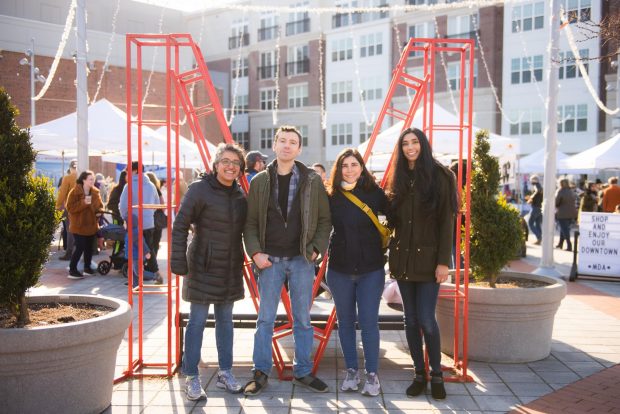
Photo of the winter market at Metuchen Town Plaza, full of tents hosted by local shops. The downtown offers a walkable, pedestrian-friendly space for events and gatherings. Used with permission of the Borough of Metuchen and Metuchen Downtown Alliance.
“It’s been a great boom for the local economy here and has been a nice renaissance for the town. I grew up in South Edison. We used to just cut through Metuchen as a pass-through to other parts of Edison. Now when I come through Metuchen, there’s a reason for me to come down here and stop. I can have dinner here. It’s not just a pass-through anymore,” said Luigi Beltran, owner of Luigi’s Ice Cream in downtown Metuchen.
In 1981, Metuchen first released a 20-year analysis and plan called Metuchen 2001, collaborating with a Rutgers University urban design studio. This effort sought to plan for efficient land use along Main Street, to produce a more active, safe, and lively downtown. By 2001, Metuchen was declared a Transit Village in only the second year of the state’s Transit Village program.
New Jersey Future first honored the Borough of Metuchen in 2004 for its Town Center Design and Development plan with a Smart Growth Award. Again in 2017, Metuchen received a Smart Growth Award recognition for its Woodmont Metro at Metuchen Station, a project designed to help implement the plan. The repeated recognition that Metuchen has received for the development of its downtown and train station is indicative of the community value that can come from transit-centered revitalization and smart growth, offering an example for commuter towns and transit villages across the state to follow moving forward.

Photo from before Metuchen prom at Metuchen Town Plaza. Students gather to take a selfie in the downtown plaza area. Used with permission of the Borough of Metuchen and Metuchen Downtown Alliance.
Among the most notable steps toward smart growth and good urbanism in the Metuchen Station redevelopment project was the Borough’s move to rezone the downtown to allow residential units above businesses. Not long after Woodmont Metro was constructed in 2016, the developer constructed “The Hub,” a mixed-use project with roughly 80 apartments and first-floor retail, made possible by the new zoning ordinances. This, coupled with efforts to create a more walkable, pedestrian-friendly streetscape and various in-fill development in the downtown, established a more connected, walkable community in Metuchen that provides access to retail, food, businesses, and mass transit alike. At the same time, the Borough has successfully redeveloped more than 100 acres of land of abandoned, decommissioned, and otherwise underutilized former warehouses, auto dealerships, lumberyards, and even freight lines. Now, these spaces have been revitalized for mixed-use enterprises, whether as office and commercial space or as residential units. Walking in downtown Metuchen today, one can find art collectives and dance studios, fitness centers and yoga studios, cafes and sushi bistros, and boutiques and salons—many of which are women and minority-owned businesses.

Photo of people breakdancing at Metuchen Town Plaza. Used with permission of the Borough of Metuchen and Metuchen Downtown Alliance.
“Woodmont Metro was the catalyst for over $170 million of investment. More than 150 new businesses were started since 2016, of which 89% are still in business today. The average resident brought $14,231 in spending according to market analysis. When Woodmont Metro and all other development is added up, the 387 apartments helped to generate $5.5 million of new spending each year,” explained Isaac Kremer, former founding executive director of the Metuchen Downtown Alliance and former employee with Woodmont Metro. He went on to outline the significance of this data for Metuchen’s downtown community, vibrancy, and energy. “The Town Plaza has subsequently become the heart of the community hosting events throughout the year. Walkability has increased with more people choosing to ditch the car and enjoy walking our streets and sidewalks in Metuchen. Lastly, market research shows over 70% of customers are coming from outside of Metuchen. So by making Metuchen more livable, we’ve also become a regional destination.”
The Borough’s redevelopment not only has supported activity and color in the downtown of Metuchen, but also has fostered resilience in the community, even through the COVID-19 pandemic. Muldoon explained, “Through a strong collaboration between the Borough and our Special Improvement District, the Metuchen Downtown Alliance (MDA), programs were put in place to enable businesses to not just survive, but many to thrive through the pandemic. The MDA secured funding through various grants, including Main Street New Jersey, that was used to support restaurants and other businesses’ efforts to pivot to new ways of doing business. The MDA assisted businesses in seeking pandemic relief funds and worked with the Borough to create outdoor dining areas in public spaces and in Borough right of way areas. As a result, very few businesses closed because of the pandemic and many new businesses decided to open in Metuchen due to the strong support provided to our business community.”
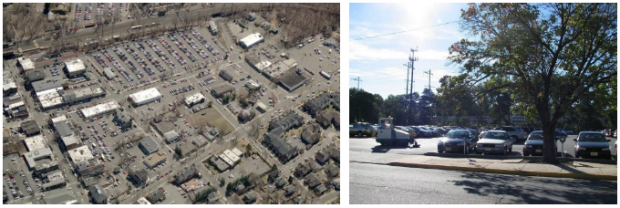
Photos of Pearl St. parking lot in downtown Metuchen before redevelopment, where Woodmont Metro is now located. This former parking lot is now vibrant with life and community. Used with permission of the Borough of Metuchen and LRK.
The Woodmont Metro at Metuchen Station has redeveloped a former commuter parking lot into a parking garage with additional retail space and nearly 300 housing units, 15% of which is affordable housing. The project has also established a half-acre public outdoor space for community use, which became a particularly significant part of the community amidst concerns around indoor public gatherings during the COVID-19 pandemic. The outdoor space is frequently used for weekly farmers’ markets, among other community events.

Photo from inaugural Pride on the Plaza at Metuchen Town Plaza during summer 2022. Used with permission of the Borough of Metuchen and Metuchen Downtown Alliance.
Through this sustained and widespread effort at development and redevelopment, Metuchen has emerged as a real community center, as opposed to merely a stop on the way to an end destination. In NJF’s review of notable smart growth projects over the past two decades, Metuchen’s downtown revitalization efforts demonstrate a uniquely sustained and successful commitment to community development and resilience, embodying the meaning of this award. Metuchen shows us how orienting development around transit increases the benefits for local community members and businesses, but also for those from adjacent towns that may lack such a rich and accessible commercial downtown.
Metuchen’s downtown still has room to grow. Former Founding Executive Director of the Metuchen Downtown Alliance Isaac Kremer highlighted opportunities for improvement, explaining how retail and work spaces could be better integrated at the ground level, making Metuchen’s downtown more integrated and walkable. “[W]e lost a ground floor retail opportunity connecting Main Street with Whole Foods and the surrounding commercial property. There was some discussion about the ground floor ‘terrace’ apartments being made into live-work spaces. Instead these are standard apartments and do not add to the ‘interesting walk,’ as Jeff Speck called it in Walkable City. That prevents people circulating further out. Additionally, the opposite side of the street is still surface parking lots and undeveloped. Hopefully these will be redeveloped some time soon, so we have buildings framing each side of the street.”
The Borough’s Jay Muldoon sums it up well. “Downtown Metuchen’s renaissance is not complete. Metuchen is well on its way to becoming the regional hub of commerce it once was, and is already a preferred destination for area residents for dining, professional services, retail and arts. The Borough continues to work on plans for the creation of the Metuchen Arts District to be anchored by the Forum Theatre, which will enliven another part of our extended downtown. Some might say the best is yet to come.”
__________________
1This blog is derived from an internal review conducted by New Jersey Future on our Smart Growth Award winners from the past 20 years. Metuchen, having won two awards for their downtown revitalization efforts in 2004 for their plan and again in 2017 for its implementation, is a standout example of smart growth in New Jersey.
New Jersey Future (NJF) at the White House
February 6th, 2023 by Hannah Reynolds
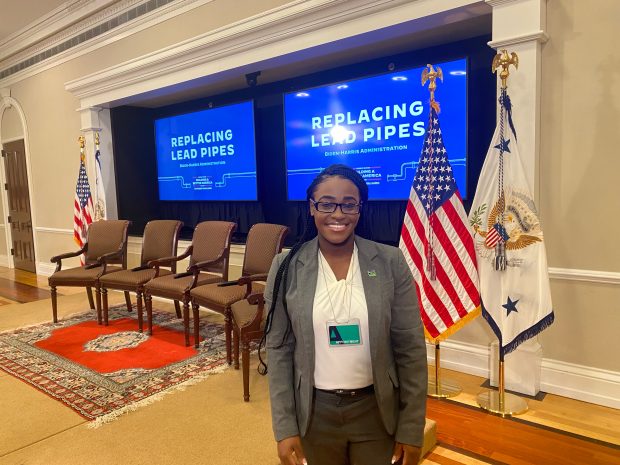
NJF Policy Manager Deandrah Cameron at the White House Summit on Accelerating Lead Pipe Replacement.
On January 27, 2023, New Jersey Future’s very own Deandrah Cameron—policy manager and backbone staff for Lead-Free NJ and the Jersey Water Works’ Lead in Drinking Water task force—represented NJF and the state of New Jersey at the White House Summit on Accelerating Lead Pipe Replacement, part of the Biden-Harris administration’s Lead Pipe and Paint Action Plan. Deandrah was one of many leaders in water policy invited to attend the event, which brought together experts from four states (New Jersey, Pennsylvania, Connecticut, and Wisconsin) to learn about and collaborate to address the issue of lead in drinking water across 40 communities. The Lead Service Line Replacement Accelerators program is a collaborative effort between the Environmental Protection Agency (EPA) and state partners across the four states represented at the summit. State partners include mayors and government officials, utilities, and water policy advocates, nonprofits, and funders, as well as the US Department of Housing and Urban Development, and the NJ Department of Environmental Protection (NJDEP) and equivalent departments from across the four states. New Jersey and NJF were invited in recognition of our leadership on lead issues. Over time, New Jersey, along with the three additional states, will serve as a model for other states grappling with the chronic issue of lead in the drinking water.
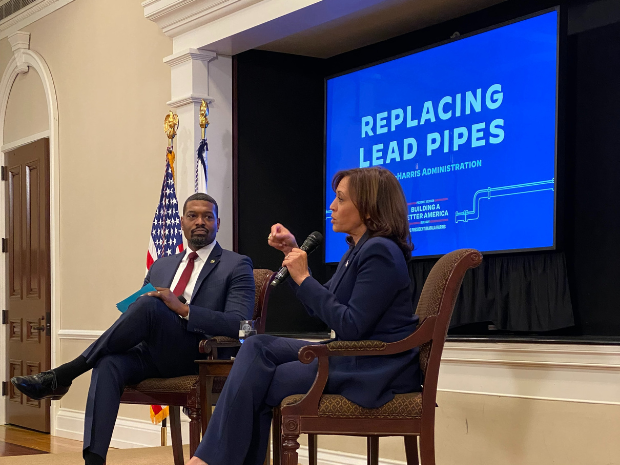
Vice President Harris speaking at the White House Summit on Accelerating Lead Pipe Replacement.
“We got to hear from Vice President Harris, who dubbed herself a water policy nerd—we were all really excited to hear her go on and on about the topic we are so passionate about,” Deandrah shared, remarking on her experiences at the summit. Another speaker who particularly stood out was a woman named Deanna Branch, an advocate with the Milwaukee-based Coalition for Lead Emergency, whose nine-year-old son had experienced lead poisoning, which kicked off her work in organizing for clean drinking water. “As someone working in policy who is not always on the ground in communities, it was good to see and hear from someone who is impacted by lead and who is excited to see that we are taking this issue so seriously. Hearing Deanna speak was a major highlight from the summit,” remarked Deandrah, reporting back on the highlights of her trip to the White House.
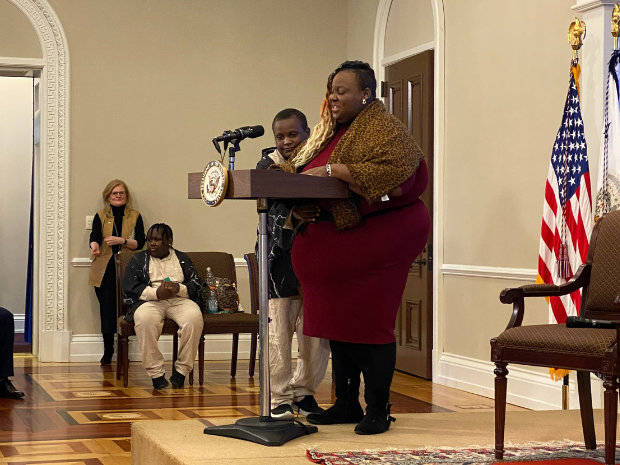
Milwaukee-based Coalition for Lead Emergency advocate Deanna Branch speaking with her nine-year-old son by her side.
At the summit, the work being done in the state of New Jersey to address lead in drinking water was elevated as a model of what lead service line replacement can look like. “New Jersey is seen as a pioneer in the field of water quality, and it’s good to see our state considered as a leader,” Deandrah explained of NJ’s leadership role in the collaborative effort toward lead pipe replacement in the four states. During the summit, mayors served on panels alongside state representatives and utilities, including Director Kareem Adeem of Newark’s Department of Water and Sewer Utilities and NJDEP Commissioner Shawn LaTourette. Deandrah recounted watching NJ representatives speak, stating that “Being from New Jersey, it was cool seeing Kareem Adeem from Newark—one of the people we work closely with on the JWW Lead in Drinking Water task force—and the commissioner of NJDEP talking about what the City of Newark is doing and offering support for other utilities and cities, all on a national platform.”
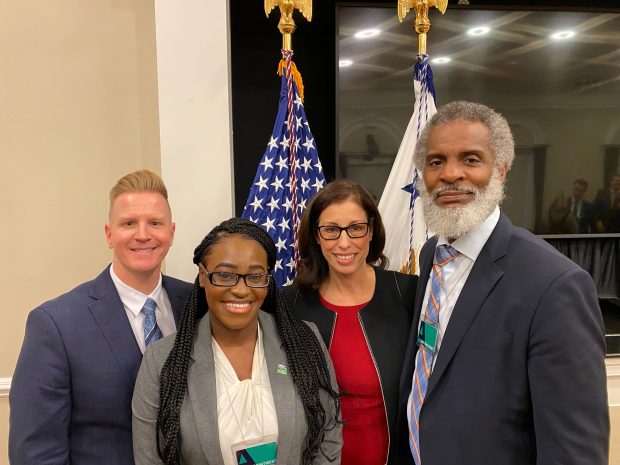
From left to right: NJDEP Commissioner Shawn LaTourette, NJF Policy Manager Deandrah Cameron, Mayor of East Newark Dina M. Grilo, and Newark Department of Water and Sewer Utilities Director Kareem Adeem.
In his remarks on a panel at the summit, Kareem Adeem offered sound advice based on his experiences in Newark in lead service line removal. “Communication, communication, communication. You may not always get it right, but that doesn’t mean you stop. You continue to communicate. You continue to, you know, acknowledge those times when you made a mistake, you should always acknowledge it, but you continue to move forward… Overall, the political collaboration with the local government, the county, and the state, [it made it so] we were able to [remove the lead service lines].” Of the work done by Adeem and many other leaders in the City of Newark, Vice President Harris remarked, “Other cities and other families and children around our country will benefit from the work you did right here.”
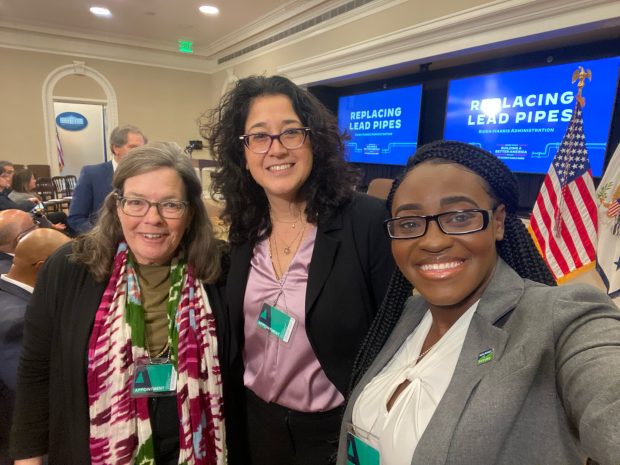
From left to right: Clean Water Action Campaigns Director Lynn Thorp, Environmental Policy Innovation Center (EPIC) Chief Strategy Officer & Director of Water Strategy Maureen Cunningham, and NJF Policy Manager Deandrah Cameron.
All in all, NJF appreciates the opportunity for Deandrah to represent NJF amongst water policy leaders from across the country. Deandrah shared some final reflections which illustrate the significance of the White House Summit personally, for our partners, and for the state of New Jersey. “In my role at NJF, I have the opportunity to hear from two great collaboratives: Jersey Water Works and Lead-Free New Jersey. I work with some of the smartest people in the state on lead issues, and to see their work elevated and validated in having New Jersey Future be selected as a partner for the White House Summit on Accelerating Lead Pipe Replacement is incredible. One of the goals of our Get the Lead Out partnership is to convene all representatives quarterly. Currently, I meet with the experts in our collaborative monthly and we get in the weeds on lead, so to be able to elevate our mission across states and share our expertise is so powerful. I never imagined taking the work beyond the walls of NJ, so to get to work across four states and 40 communities shows that our work is transcending state lines. I used to have a goal of every city in New Jersey being like the City of Newark and having lead-free drinking water, but now I have a vision of all 40 cities in the partnership, and all cities in the US. My enthusiasm and vision and goals around water quality have expanded because we’re now working at a national level.”
Helping NJ Drive Less: The Need to Dedicate Funding to Transit and Safe Streets
January 31st, 2023 by Kimberley Irby
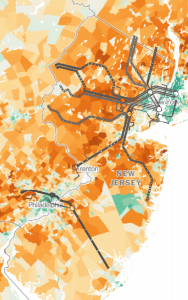
The New York Times (NYT) Climate Impact Map of New Jersey overlaid as closely as possible with NJ Transit lines, emphasizing the NYT data which shows how people living in denser areas, where there is typically less driving, are responsible for fewer carbon emissions.
Electric vehicles are great, but they won’t reduce greenhouse gas (GHG) emissions in the transportation sector fast enough, nor will they do anything to alleviate congestion. This past October, the United Nations published the Emissions Gap Report 2022, declaring that an important action for the transportation sector is to “integrate land use and transportation planning to prioritize public transit over private automobiles.” As we confront climate change alongside congestion, road fatalities, and high gas prices, it is imperative that New Jersey not only facilitates increasing electric vehicle adoption, but focuses on the range of solutions that encourage people to drive less.
Though record-high gas prices last year reminded us of the expense of vehicle ownership, the costs of car dependency are more than economic. Traffic deaths are on the rise, revealing the human cost of our dangerous streets and roads. People waste precious hours of their lives idling in traffic, which emits pollution that disproportionately harms low-income and Black and Brown communities too often encroached upon or divided by urban highways. Meanwhile, there are many benefits of transit, biking, and walking, including improvements in affordability and equity, health and safety, climate and economy, and increasing leisure time.
State and federal transit agencies, nonprofits, and private partners are aiming to reduce our dependence on private vehicles, but there is much more to be done. Alternatives to driving mostly include active transportation (e.g., walking, biking, rolling) and public transit (e.g., bus, rail, light rail). We must ensure more money and planning goes towards those activities. This would mean sufficient capital and operating funds to ensure public transit is efficient and reliable and active transportation routes are safe and accessible.
We can also address the issue of car-dependency through the lens of land use: building destinations closer together, ensuring safe connectivity between transit stations, and creating safe streets. What is known as “Complete Streets” design and implementation is crucial to improve safety and accessibility for all active transportation modes. Overall, there is a need to be more intentional about creating places and investing in infrastructure that support both driving shorter distances and using other modes of getting around.
NJ Transit, in particular, is a vital service and tool in helping New Jerseyans drive less. It is the nation’s largest statewide public transportation system of buses, rail, and light rail, and it serves nearly one million riders per day. Despite its potential to get people out of cars, there is currently no reliable, dedicated source of funding for the system’s essential operating needs. For years, NJ Transit has relied on rider fares and funding diverted from various sources, such as the state’s Clean Energy Fund, to sustain itself. Since the onset of the pandemic, NJ Transit has utilized federal relief to plug budget gaps, but the agency faces a fiscal cliff when aid money runs out in 2026. With the push for more electric vehicles on the road, gas tax revenue is expected to shrink, reinforcing the imperative to find a steady source of funding elsewhere.
NJ Transit requires capital funds to maintain a state of good repair, upgrade the existing system, and become more environmentally sustainable, by, for example, acquiring electric buses. Operating funds are just as vital, allowing the agency to provide reliable, affordable service. The first draft of next year’s state budget will be issued in February, and now more than ever, we need our legislators to commit to adequate funding for NJ Transit operations, both in the short- and long-term, that does not detract from the agency’s capital budget or the state’s Clean Energy Fund. Strengthening NJ Transit helps all New Jerseyans when it comes to transportation: it directly supports those who do not want to rely on or are not able to afford private vehicles, and indirectly supports drivers by reducing congestion.
We all benefit from living and working in places where we have the flexibility to move between critical places without relying on a car, and we should demand relevant solutions from our elected leaders. Whether you walk, bike, ride public transit, or simply want reduced congestion, prioritizing funding for strategies that can ultimately help reduce car dependency improves all of our commutes and air quality. As we strive to reduce our greenhouse gas emissions, especially from transportation, and to be a state that is rich with various mobility options, we must prioritize center-based design, implement safe street design, and provide operating funds for public transit. Doing so will not only help us mitigate the climate crisis, but also will enable better placemaking to improve the lives of all New Jerseyans.
Transit-Oriented Development is Pedestrian-Oriented Development
January 30th, 2023 by Tim Evans
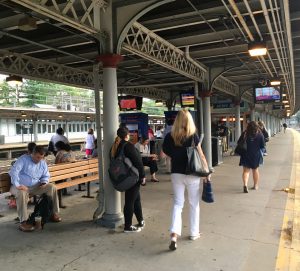
Trenton Transit Center, Trenton NJ. Photo Credit: New Jersey Future
Despite being the most densely populated state in the country with over 150 train station towns, New Jersey is not a safe place for pedestrians of any age. In our effort to reduce car dependency, increase pedestrian safety, and encourage placemaking that serves the public, NJ ended 2022 with several announcements designating funds for advancing pedestrian and bicycle safety and transit-oriented development (TOD), indicating that the administration recognizes the importance of creating and fostering transportation options besides driving. Here’s a few recent developments of note:
- NJ Transit receives federal grant funding to study light rail in Hudson and Bergen Counties. [NJ.com]
- New engineering contract indicates major step forward for light rail line connecting Camden and Glassboro. [NJ.com]
- Murphy Administration disperses money across 56 municipalities to implement street safety and connectivity projects. [ROI-NJ]
The common goal among these projects is compact, walkable urbanism. Transit-oriented development must be pedestrian-oriented development, since transit riders become pedestrians the moment they step off the bus or train. Before private automobiles became the default method of transportation, most towns, including most of New Jersey’s urban centers and first-generation “streetcar” suburbs, were designed with walking in mind. The whole point of transit-oriented development was to enable transit riders to safely access the station on foot, and to access other commercial destinations along the way. These same clusters of destinations also made trips shorter and more efficient, often without needing a car, for other local residents who were not transit commuters.
These older centers present a massive opportunity for NJ to reduce car dependency. Centers with multiple destinations (sometimes including a transit station, sometimes not) located within easy walking distance fell out of favor in the second half of the 20th century, as automobile ownership became nearly universal and development patterns changed to focus on accommodating cars rather than people. But the legacy of walkable urbanism is still visible in New Jersey’s relatively low rate of vehicle ownership, compared to other states that experienced most of their development after the car became dominant. In NJ, 11.2% of all households1 do not own a vehicle, the third-highest rate in the country after New York and Massachusetts. (This translates to about a million people who are reliant on some other mode of transportation besides a car for their daily needs.) And another 34.8% of households have only one vehicle available, bringing the share of NJ households that are able to live either car-free or “car-light” (only one vehicle) to 46%, or almost half.
The good news is that towns that embody the live-work-play-shop environment are becoming popular again, giving states like New Jersey with many older centers a competitive advantage. The 153 municipalities in New Jersey that host a transit station (rail, ferry, or major bus terminal) accounted for 68.6% – more than two-thirds – of total statewide population growth between 2010 and 2020, up substantially from only 27.8% of total growth in the 2000s and 35.8% in the 1990s. More precisely, the 124 municipalities that best embody the concept of walkable urbanism (with or without transit stations) and score high on all three New Jersey Future smart growth metrics—high activity densities (people + jobs per square mile), mixed-use downtowns, and well-connected, walkable street grids—together accounted for more than half (57.5%) of the statewide population increase in the 2010s, compared to only 13.6% of total growth in the 2000s.
Compact, walkable, mixed-use centers produce a host of societal benefits. For one thing, given the transportation sector’s outsized role in the state’s overall carbon footprint, enabling people to take at least some of their trips on public transit, or by non-motorized means —and shortening travel distances for those trips that are still taken by car—is an effective strategy to reduce the state’s greenhouse gas emissions without waiting for electric vehicles. Reducing the need to drive by making non-driving options more accessible and comfortable would also address other problems that electrifying the vehicle fleet will do nothing to resolve, such as reducing traffic congestion, improving pedestrian and bicyclist safety, reducing the expenses involved in owning a vehicle (especially important for lower-income households), allowing people to spend less time in the car commuting and running errands, improving public health as a result of more people using more active modes of transportation, and reducing per-capita infrastructure needs and the public expenditures they engender.
To encourage less car dependency, alternatives must be safer, more enjoyable, and available to more people. To this end, transportation planners at the New Jersey Department of Transportation, New Jersey Transit, and at the county and municipal level need to include the needs of non-drivers as an integral part of the planning process and not just as an afterthought. This includes incorporating pedestrian improvements into efforts to promote TOD. Because all users of the transportation system are pedestrians at some point.
__________________
12021 American Community Survey one-year estimates
New NJDEP Watershed Improvement Plan Requirement and What This Means for Municipalities
January 4th, 2023 by New Jersey Future staff
By Lindsey Sigmund and Patricia Dunkak
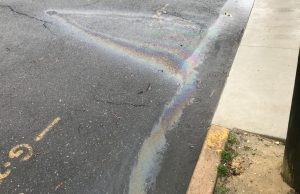
Stormwater picks up oil, trash and other contaminants. If it is left untreated, the stormwater conveys the contaminants into streams. Photo credit: Andrew Tabas. Location: Bordentown, NJ
In our highly developed state, upgrading and retrofitting New Jersey’s stormwater infrastructure and reducing impervious cover is a key way to address nonpoint source pollution. It is estimated that up to 60% of the State’s existing water pollution is attributable to stormwater and nonpoint sources of pollution. Stormwater best management practices (BMPs), including green infrastructure, are an integral part of improving the quality of New Jersey’s lakes, rivers, streams, and bays, and reducing dangerous flooding events worsened by climate change.
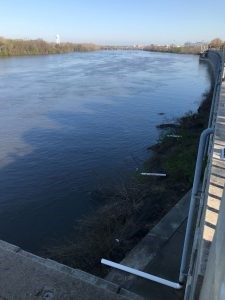
Pipes convey stormwater from impervious surfaces into the Delaware River. Photo credit: Andrew Tabas. Location: Trenton, NJ.
New Jersey’s Department of Environmental Protection’s (NJDEP) newly issued MS4 permit reflects a move toward watershed level planning for addressing water quality issues and flooding in New Jersey’s communities. The 2023 Tier A Municipal Separate Storm Sewer System (MS4) permit went into effect on January 1, 2023, and the implementation of its requirements on the local level will help address water quality and stormwater issues related to new and existing development. New Jersey already has a high number of impaired water bodies and experiences frequent flooding. The problem is anticipated to get worse: according to the New Jersey Scientific Report on Climate Change published in 2020, “surface and groundwater quality will be impaired as increased nutrients and contaminants enter waters due to runoff from more intense rain events.” The new MS4 permit is an opportunity to improve local implementation that will protect New Jersey’s waterways in the face of climate change.
What is an MS4 permit? The state issued permit requires municipalities with separated stormwater systems—essentially any municipally owned stormwater infrastructure that is not a combined sewer system (CSS)—to address their Total Maximum Daily Loads (TMDLs). The TMDL program identifies impaired streams and the pollutants contributing to their degradation. Despite prior MS4 permits and their requirements for municipalities to address water quality impairments, an overwhelming number of municipalities have not achieved compliance, and many of New Jersey’s waterways are still considered impaired.
What this new permit means for municipalities. A significant shift from 2018, when the last permit went into effect, is the change in the number of municipalities that are now considered Tier A. All towns previously considered Tier B, over 100 municipalities, have been reclassified as Tier A. This reclassification means all of New Jersey’s municipalities are subject to permitting obligations informed by federal regulations, which include more stringent requirements set forth in the Clean Water Act. Another significant change from 2018 is the inclusion of a Watershed Improvement Plan (WIP) requirement. The WIP process and its eventual implementation will begin to address nonpoint source pollution throughout New Jersey. This process includes three phases for communities to map out actions to improve water quality by reducing pollutants and reducing or eliminating flooding in municipalities. The three steps to the WIP process over the five year permit cycle include:
- Mapping: Municipalities are required to map all publicly and privately owned stormwater infrastructure, impervious cover, and other relevant data by 2026.
- Planning: Communities will outline potential water quality improvement projects, provide an estimate of funding necessary for these improvements, and provide other relevant water quality data by 2027.
- Final Plan and Implementation: Municipalities will submit final project locations for water quality improvement projects by 2028.
Despite progressive state requirements, there will be compliance obstacles. Resources are currently available for municipalities to get started, but more guidance and technical assistance is needed to ensure compliance, especially for reclassified Tier B permittees. New Jersey Future and partners will update and provide resources for MS4 permittees made available through the New Jersey Green Infrastructure Municipal Toolkit. Another obstacle is funding. NJDEP has identified stormwater utilities as one of the potential funding mechanisms for WIPs and other MS4 permit obligations. Stormwater utility fees, based on how much hard surface, such as rooftops or pavement, is on a property, provide a dedicated source of funding for upgrading and maintaining stormwater infrastructure, including green infrastructure. However, state agencies could and should provide additional funding through grants to supplement financing provided through the state Water Bank to ensure compliance.
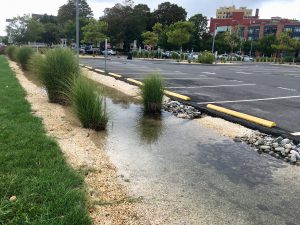
Bioswale in a parking lot in Asbury Park, NJ. Image Credit: New Jersey Future
Stormwater pays no mind to municipal or political boundaries. This new state mandated watershed planning approach to addressing water quality and flooding is a step in the right direction. However, watersheds, much like flood waters, do not follow municipal boundaries. Therefore municipalities should be working together to share resources and plan on a regional level to effectively address stormwater issues in their watersheds. If properly implemented, this new permit will improve water quality and reduce flooding, which is more important than ever as New Jersey braces for and seeks to minimize the impacts of climate change.
NJDEP Finalizes Water Infrastructure Investment Priorities for 2023
November 29th, 2022 by New Jersey Future staff
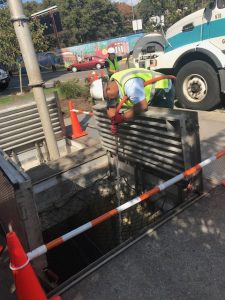
Photo Credit: Moriah Kinberg
By Brianne Callahan and Lindsey Sigmund
All New Jerseyans deserve to drink clean water, to avoid flooding and sewage backups in their homes and neighborhoods, and to pay affordable water and sewer charges. Every single one. Unfortunately, we’re not there yet. Today, our state’s outdated, overwhelmed, and undersized water systems are failing at an alarming rate, endangering public health and public safety, and holding us back from being the healthy, vibrant, and resilient state that we want to be. Staggeringly, an estimated $26 billion is needed to fix New Jersey’s water infrastructure over the next 20 years.
The good news is that we’re getting closer. To begin addressing our infrastructure funding gap, our Governor and Legislature allocated $300 million of New Jersey’s American Rescue Plan Act (ARPA) dollars in June, 2022. Following our state leadership’s example, the New Jersey Department of Environmental Protection (NJDEP) announced that $248 million of this ARPA funding will be used to address combined sewage overflows (CSOs), in which localized flooding and raw sewage is dumped into rivers and streams from older water systems. This is welcome funding for New Jersey’s 21 CSO communities, and we are excited about what this funding will accomplish. It certainly seems like a lot of money, but it’s only a small fraction of the billions needed to improve our water infrastructure.
Let us explain. Throughout New Jersey, there are a myriad of infrastructure needs. Our systems have been sorely neglected over the last 50 years, and, in addition to addressing CSOs, communities are required to replace lead service lines by 2031 and comply with ever increasing stormwater management requirements—a necessary, but often prohibitively costly step towards building more resilient water systems in communities. The NJDEP Intended Use Plan for federal and state water infrastructure funding includes 679 water infrastructure projects in need of approximately $6 billion in funding. The $300 million in ARPA funding mentioned above is expected to be paired with the $1 billion for water infrastructure received from the federal Bipartisan Infrastructure Law over the next five years. If you do the math, this equates to an estimated $4.7 billion gap in funding for the backlog of projects outlined in the Intended Use Plan. Further piling on, this number does not include high priority projects not yet identified and/or submitted by localities due to timing or lack of planning resources. This funding gap demonstrates in no uncertain terms the priority which water infrastructure improvements must be given in the coming years and decades, in order to protect our communities and avert even greater crises in the future.
So, let’s keep our foot on the proverbial gas. Continuing their problem-solving leadership, the Governor and the Legislature should allocate a significant portion of the estimated $1.4 billion in remaining ARPA dollars to address this funding gap and ensure ratepayer relief for New Jerseyans who would otherwise see increases in water bills, sewer bills, and possibly local property taxes. Every New Jerseyan deserves access to clean and healthy water systems, and it is the responsibility of our elected leaders to ensure this is the case.
PFAS in the Garden State: What It Is and What We’re Doing About It
November 11th, 2022 by New Jersey Future staff
By Hannah Reynolds and Brianne Callahan
If the increased prevalence of the term “perfluoroalkyl” has you scratching your head, you’re not alone! Read on to learn about per- and polyfluoroalkyl substances (PFAS), why you should care, and what we’re doing about it here in New Jersey.
Perfluoro- what?!
In addition to being incredibly difficult to pronounce, per- and polyfluoroalkyl substances (PFAS) are a large class of human-made chemicals that repel water and oil and are resistant to heat and chemical reactions. Two of the most prevalent PFAS compounds are perfluorooctanoic acid (PFOA) and perfluorooctane sulfonate (PFOS). They are commonly used in commercial and manufacturing applications, and unfortunately they are becoming more and more infamous as they are linked to serious health effects for humans and animals.
Manufacturing of PFAS chemicals began in the 1940s, to create non-stick cookware, firefighting foam, and many other common products including detergents, fast-food wrappers, paints, and even beauty products. Most famously, PFAS chemicals are present in DuPont’s teflon cookware—a fact your grandparents could most assuredly corroborate.
Why You Should Care
There’s no sugarcoating it—PFAS pose a big problem. These chemicals are linked to serious health issues for humans and animals alike, and they are wreaking havoc on communities across the United States. Known as “forever chemicals,”contaminants in the PFAS family accumulate in the body over extended periods of time, and are associated with a higher risk of health problems including liver damage, thyroid disease, decreased fertility, high cholesterol, obesity, hormone suppression, and cancer. PFAS can pass into our bodies through water, food, and air, and their usage is widespread. It is found in food packaging and textiles, is sprayed on agricultural fields through biosolids, and it seeps into groundwater at commercial sites, airports and military bases. Widely accepted estimates indicate that one-third of Americans drink water contaminated with PFAS, though more recent studies suggest that exposure to PFAS may be much higher.
New Jersey is no exception. In fact, New Jersey is among the top three states, behind Michigan and California, in the prevalence of PFAS. A 2015 study of Northeast waterways—the first to examine endocrine disruption in US national wildlife refuges— indicated estrogenic contaminants like PFAS were present in the water, having feminizing effects on male fish. Just last year, six towns in the Garden State discovered unsafe levels of PFAS in their drinking water. PFAS chemicals are estimated to be present in the drinking water of roughly 6% of 9.2 million New Jerseyans, with 34 community-based and 40 non-community-based water systems exceeding state thresholds for safe levels of consumption impacting over 500,000 people. Our densely-populated state is particularly vulnerable to PFAS and other toxic chemicals in our water, especially with high rates of waste, landfills, and industrial manufacturing contributing to high levels of PFAS in the water.
One of the biggest difficulties that PFAS presents is its impact on water utilities. In many cases, water utility companies are tasked with the burden of monitoring and reporting levels of PFAS in the drinking water, while simultaneously facing the consequences when levels of PFAS exceed the state and national thresholds. Utilities often must alert the public of unsafe levels, which can create alarm and tarnish the utilities’ public image; clean up the contamination or find a new supply of water; and pay the costs of both monitoring and cleanup—all the while not being responsible for the contamination in the first place. More often than not, these costs fall upon both utilities and the public’s water bills.
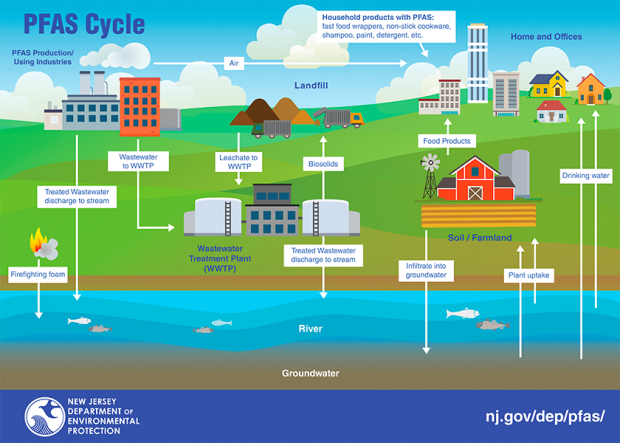
What New Jersey Is Doing To Protect Public Health
New Jersey leadership has been incredibly responsive and proactive in addressing PFAS contamination. The New Jersey Department of Environmental Protection (NJDEP) recently established strict standards for PFAS in drinking water, as the first state to adopt a maximum contaminant level (MCL) for PFAS. New Jersey has an MCL for a few PFAS compounds: 14 parts per trillion (ppt) for PFOA and 13 ppt for PFOS. As of last year, the state requires all public water systems to be monitored for these chemicals. If you learn that PFAS have been detected in your drinking water above the New Jersey MCL, consult the current recommendations for limiting exposure from the US-EPA here.
In addition, the state is addressing the source of PFAS. In 2019, the NJDEP ordered five companies (3M, DuPont, DowDuPont, Chemours, and Solvay) to pay millions of dollars for cleanup of PFAS under the Spill Act, demonstrating the capacity for the state to enforce such measures and ensure adequate cleanup takes place. We need New Jersey’s strong leadership to continue as the state addresses this pervasive threat to environmental and public health.
Next Steps
Though we’ve gotten a good start here in New Jersey, there is much to do with regards to PFAS. A number of opportunities exist to address PFAS through investment in technology, funding for water quality remediation and treatment efforts, advocacy for stricter policy at the state level, enforcement of strict monitoring for contaminant levels, and holding polluters accountable. In Wisconsin, an innovative study lends us hope, as it has shown great success in decreasing concentrations of PFAS in the soil through the use of microbes which break down the compound. With the announcement of $1 billion of the state budget allocated to water infrastructure over the next five years, there are opportunities to direct funding to equip wastewater treatment facilities with the capacity to target PFAS and other contaminants in the water. At the same time, advocating for stricter standards for PFAS at the federal level can help to keep Americans safer from PFAS, following the model of New Jersey, which has one of the strictest limits on PFAS levels in the country. Currently, there is no national MCL, but the EPA recently proposed setting enforceable MCLs of 4 parts per quadrillion (ppq) for PFOA and 20 ppq for PFOS. A nationwide standard would also set the groundwork for enforcing PFAS limits under federal policy. Further, it is important to take steps to hold polluters accountable, requiring that those responsible for PFAS pay for remediation– not utilities or taxpayers. The bottom line is that keeping our communities safe from PFAS isn’t going to be easy, but if we work together and focus on transparency and creative solutions, keeping New Jersey waterways clean and healthy is attainable.











